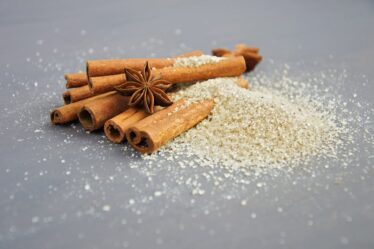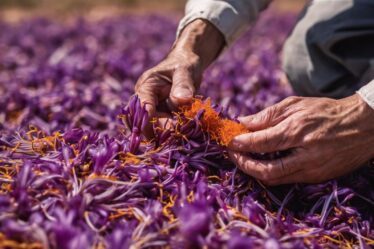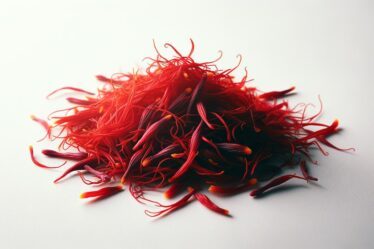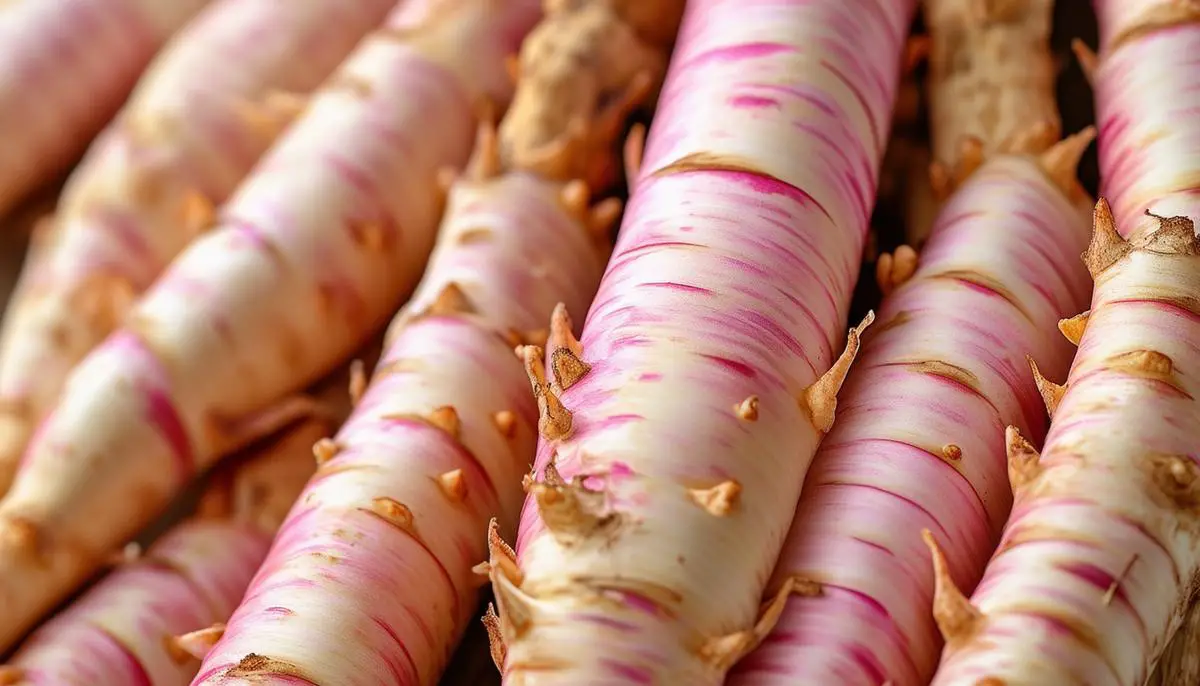
Galangal: Varieties and Forms
Galangal, a rhizome from the Zingiberaceae family, boasts two main varieties: greater galangal and lesser galangal. Greater galangal, native to Indonesia, has a pale appearance with pink nubs and is widely used in Thai soups and curries, exuding a peppery, pine flavor. Lesser galangal, rooted in Southern China, has a darker hue with orange undertones and a sharper, more medicinal flavor, finding use in traditional herbal medicines across China and India.
Galangal can be found fresh, dried, or powdered. Fresh galangal feels smoother and paler when young but turns harder as it ages, requiring culinary precision in slicing or grinding. Dried forms include sliced or chipped galangal, offering versatility and sustaining the strong, zesty essence of the fresh root. Powdered galangal, although convenient, may slightly alter the taste and texture in soups and broths but suits curries or baked goods well.
Sourcing fresh galangal typically involves visiting Asian markets or specialty stores, while dried and powdered versions offer broader availability. When buying, consider the galangal's age, as older roots are tougher to slice and offer a different flavor profile compared to younger, softer roots.
To store fresh galangal, wrap it in a loosely sealed plastic bag lined with a paper towel and refrigerate for up to three weeks. For longer shelf life, freeze sliced galangal in a sealed plastic bag or airtight container for approximately two months. Store dehydrated forms in a cool, dry place, and keep powdered galangal in an airtight container for six months to a year.
Finding a perfect substitute for galangal is challenging. Ginger can step in when necessary but lacks galangal's citrusy, earthy notes. The powdered variant is passable in some applications but might not deliver the fresh root's full punch, particularly in liquid-based recipes.

Culinary Uses of Galangal
Galangal is a cherished ingredient in various Asian cuisines. In Cambodian cuisine, it is integral to complex spice pastes known as "kroeung," serving as the foundation for hearty stews and curries. Indian cooking incorporates galangal's sharp flavor in vibrant curries, adding a citrusy note that contrasts and enhances the spiciness. Chinese cuisine, particularly in Southern China, uses lesser galangal for its medicinal properties and culinary applications in broth-based dishes and marinades.
Thai dishes showcase galangal's ability to infuse fragrant depth, notably in famous soups like "tom yum" and "tom kha gai." In "tom yum," galangal's spiciness balances with lemongrass and kaffir lime leaves, while in "tom kha gai," it marries with coconut milk, producing a creamy, aromatic soup. Indonesian cuisine features galangal as a key component in traditional dishes like "soto ayam," a chicken soup that relies on the rhizome's unique earthy-pine flavor. Vietnamese kitchens mince galangal into fresh herb salads, adding an unexpected zesty kick.
When preparing galangal for culinary use, precision is vital:
- Thin slices are the norm for soups, allowing the essence to permeate the broth without overpowering it.
- Finely mincing galangal suits salads and dressings, offering bursts of sharp, fresh flavor.
- In paste form, galangal is combined with other spices and herbs, carefully ground to create a seamless blend that elevates curries, stews, and marinades.
Embracing galangal in the kitchen involves appreciating its strong, distinctive flavor and understanding how to harness it within varied culinary contexts. Its versatility makes it valuable, whether lending its sharpness to a herbal kraeung, enhancing a creamy soup, or enriching a savory curry paste. Each method of preparation and application honors galangal's unique properties, showcasing the depth it brings to traditional and contemporary culinary creations alike.
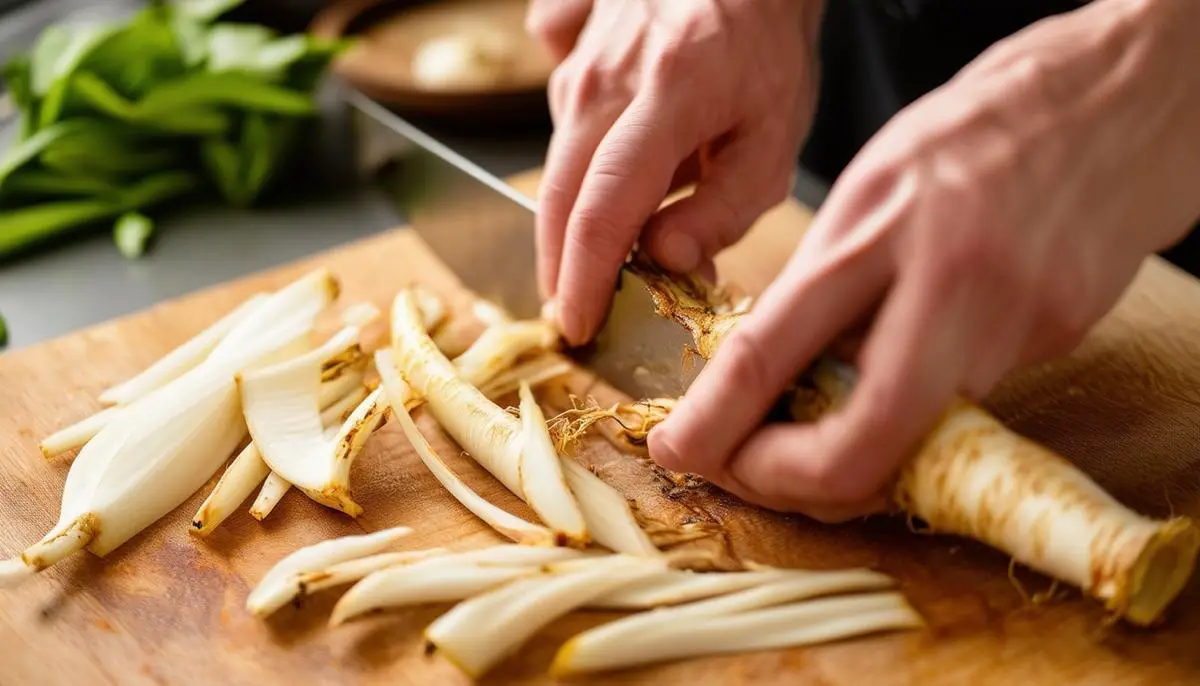
Health Benefits and Safety of Galangal
Beyond its culinary utility, galangal root offers an array of health benefits, supported by traditional practices and emerging scientific research. Its rich composition imparts several therapeutic properties that can enhance well-being when integrated appropriately into one's diet.
Galangal's prominence in traditional Chinese and Ayurvedic medicine attests to its health advantages. It is rich in antioxidants, particularly polyphenols, which have been associated with improved memory, lower blood sugar levels, and reduced LDL cholesterol1,2. However, more studies are needed to conclusively affirm these benefits specifically for galangal.
The potential cancer-fighting properties of galangal root are particularly compelling. Test-tube studies have indicated that galangin, an active compound in galangal, may inhibit the proliferation of cancer cells and even induce apoptosis3. While promising effects have been demonstrated against various cancer cells, it's essential to recognize that findings from in vitro studies don't always translate directly to humans, necessitating further comprehensive research.
Galangal also holds promise in enhancing male fertility. Evidence from animal studies and preliminary human trials suggests that galangal root extract might boost sperm count and motility4. However, the specific contribution of galangal root remains unclear, highlighting the need for further research to isolate its benefits from those of accompanying ingredients.
The anti-inflammatory and pain-relief capabilities of galangal root further underscore its therapeutic potential. Containing HMP, a naturally occurring phytochemical, galangal exhibits potent anti-inflammatory properties that can help mitigate disease-causing inflammation5. Studies indicate potential relief for osteoarthritis-related knee pain with the consumption of extracts containing galangal, but additional studies focusing specifically on galangal are needed to draw definitive conclusions.
While the health advantages of galangal are promising, it's crucial to approach its consumption with an understanding of its safety and potential side effects. Generally recognized as safe in typical culinary amounts, concerns arise when it comes to higher doses found in dietary supplements. Animal studies have noted serious side effects at high doses, including decreased energy levels, appetite loss, excessive urination, diarrhea, coma, and even death6. Until more human studies are conducted, it is prudent to adhere to moderate consumption.
Embracing galangal in your diet can contribute to overall well-being, given its antioxidant, anti-inflammatory, and potential cancer-fighting properties. Its unique blend of health benefits and culinary versatility makes it a valuable addition to any health-conscious diet. However, balance and moderation are key, particularly in the absence of extensive research on the effects of high-dose supplements.

Sourcing and Storing Galangal
Sourcing galangal opens up a journey through diverse markets and supplier platforms. While it predominantly graces the shelves of specialty Asian markets, it's increasingly finding its way into supermarket aisles and online stores, making it more accessible to culinary enthusiasts.
In Asian marketplaces and specialty stores, fresh galangal is often the most vibrant, boasting a firmness and aromatic intensity unparalleled by its dried and powdered counterparts. These markets are the epicenters for finding fresh roots, reflecting the ingredient's popularity in traditional Asian cuisines. Online retailers provide convenient access to galangal in its dried and powdered forms, and sometimes even frozen or fresh, particularly advantageous for those in regions where Asian markets are sparse.
In supermarkets, galangal's presence can be hit or miss but it's becoming more common as global palates expand. Stores like Whole Foods sometimes stock fresh galangal, especially in their Asian cuisine sections. Be on the lookout for bright, unblemished roots, typically stored alongside other fresh herbs and roots.
Choosing the right galangal involves an attentive eye for both age and quality:
- Younger roots, identifiable by their paler color and softer texture, are ideal for fresh use, being easier to slice and peel.
- Older roots, recognizable by their tougher, fibrous nature and deeper hues, contain a more concentrated flavor and are often preferred for longer-cooked dishes or for making pastes.
Maximizing the shelf life of galangal hinges on proper storage practices:
- Fresh galangal should be wrapped in a loosely sealed plastic bag lined with a paper towel, then kept in the refrigerator for up to three weeks.
- For longer preservation, slice fresh galangal into thin pieces and freeze them in a sealed plastic bag or an airtight container for about two months.
- Dehydrated or dried galangal slices, chips, or powder exhibit greater longevity when stored in a cool, dry place in an airtight container, maintaining potency for up to a year.
- Powdered galangal requires vigilant storage as it is more susceptible to flavor loss and should ideally be used within six months.
Incorporating galangal into your kitchen repertoire enriches both traditional and modern dishes with its distinct spicy and citrus notes. The careful selection and thoughtful storage of this versatile rhizome uphold its culinary integrity and celebrate its rich heritage.

Galangal's distinct flavors and health benefits make it a standout ingredient in Asian cuisine. Whether enhancing a traditional curry or offering its therapeutic properties, this rhizome enriches both culinary and wellness experiences. Embracing galangal in your kitchen promises aromatic dishes and a step towards holistic well-being.
- Chouni A, Paul S. A review on phytochemical and pharmacological potential of Alpinia galanga. Pharmacognosy J. 2018;10(1):e1100.
- Chouni A, Paul S. Phytochemical and pharmacological potential of Alpinia galanga Linn. A review. Res J Pharm Technol. 2017;10(10):e3486.
- Lo CY, Liu PL, Lin LC, et al. Antimelanoma and antityrosinase from Alpinia galangal constituents. ScientificWorldJournal. 2013;2013:186505.
- Pratap SR, Ritesh J, Rahul M, Prashant T. A comprehensive review on the phytochemical and pharmacological aspects of Alpinia galanga L. Int J Pharmacogn. 2015;2(8):397-404.
- Acharya SD, Ullal SD, Padiyar S, et al. Clinical pharmacognosy: An overview. Manipal J Pharm Sci. 2016;2(2):21-24.
- Subramanian K, Selvakkumar C, Vinaykumar KS, et al. Tackling multiple antibiotic resistance in enteropathogenic Escherichia coli (EPEC) clinical isolates: A diarylheptanoid from Alpinia officinarum shows promising antibacterial and immunomodulatory activity against EPEC and its lipopolysaccharide-induced inflammation. Int J Antimicrob Agents. 2009;33(3):244-250.

